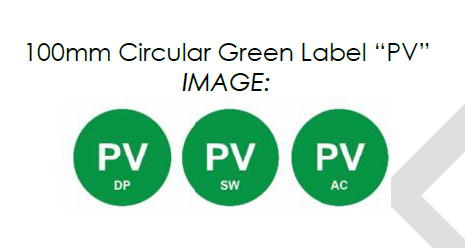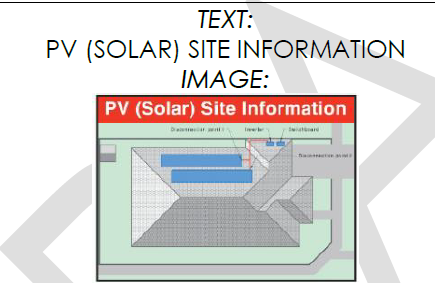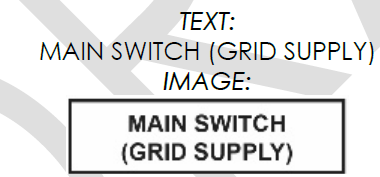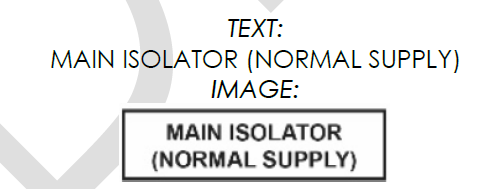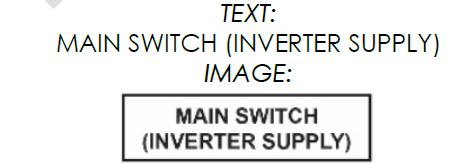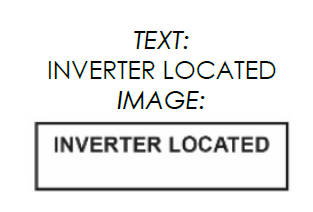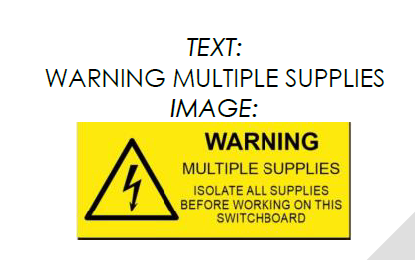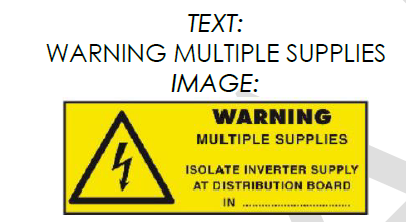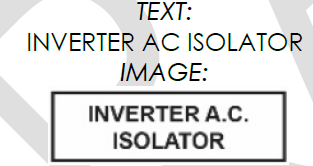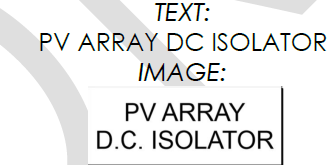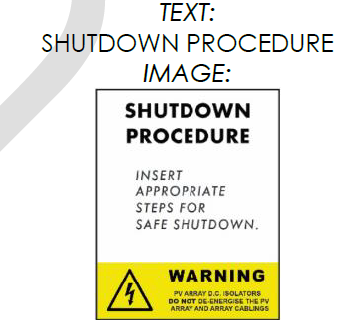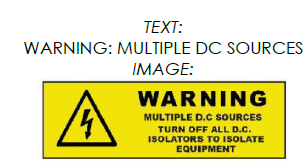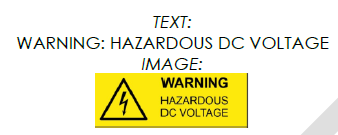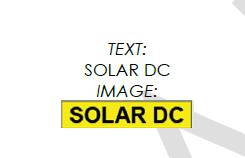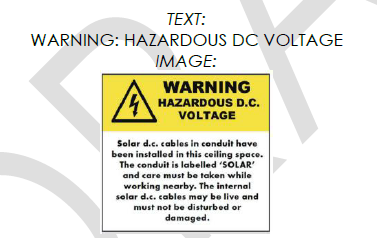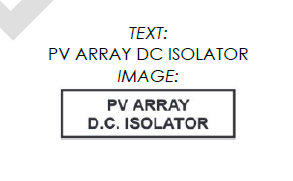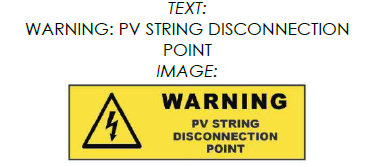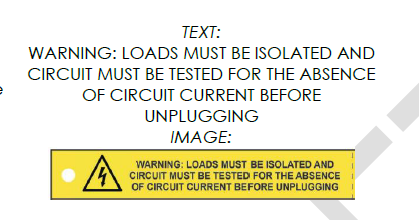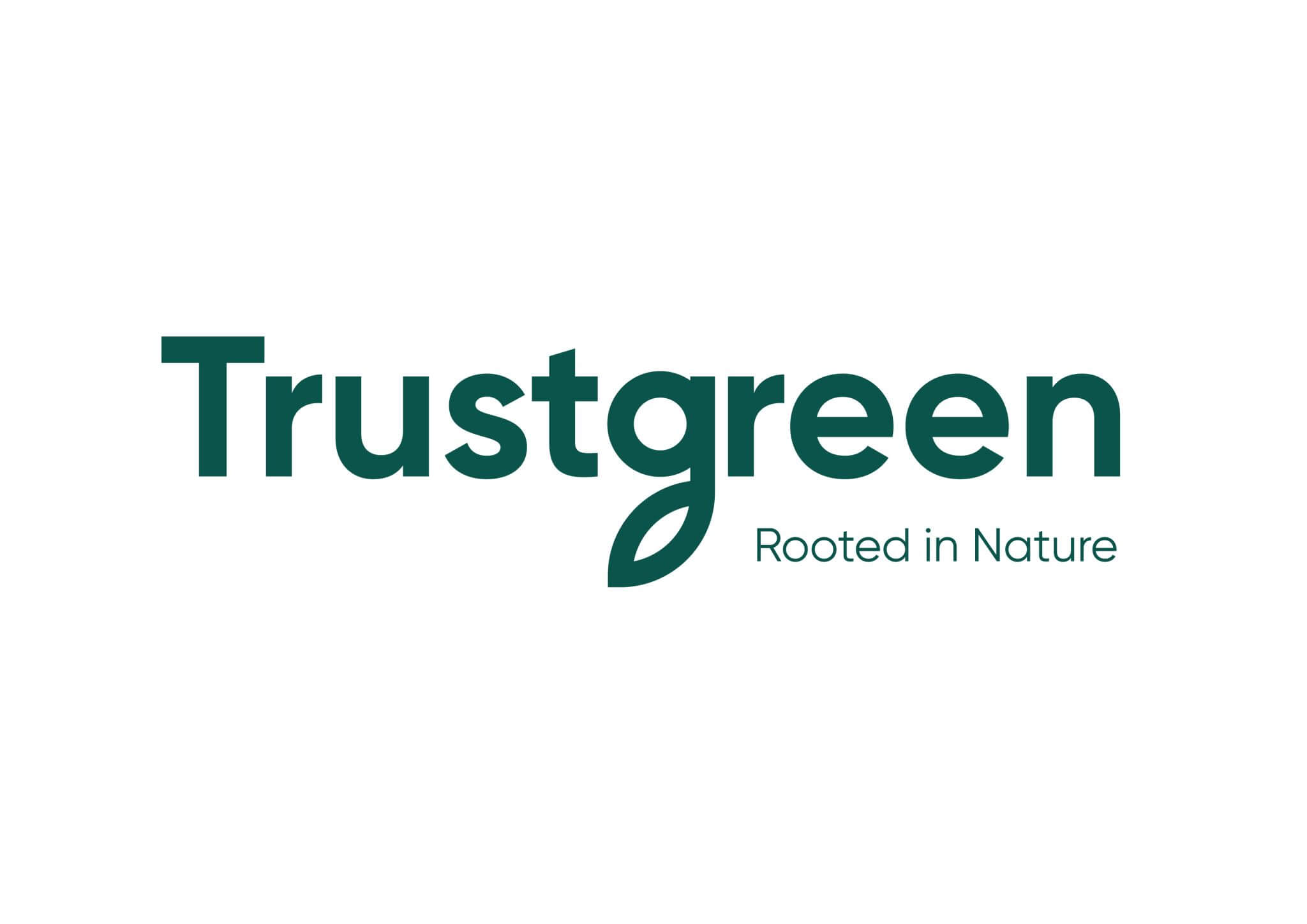Title Page
-
Site conducted
-
Conducted on
-
Prepared by
System Information
-
Size of system (kW)
-
Location of System
-
PV array mounting type
- Tilt Mount
- Flush Mount
-
Has the system been installed as per the SLD
-
Has the system been installed as per the Sturctural Certification
Inverter Bank
Labels
-
Where a system has PV array switch disconnectors the following warning<br>is installed on the inverter WARNING: PV ARRAY D.C. ISOLATORS DO NOT<br>DE-ENERGIZE THE PV ARRAY AND ARRAY CABLING - AS/NZS 5033:2014<br>5.5.3<br>
-
For systems over 600 V a warning sign indicating the following shall be<br>installed on the access door or gate: WARNING: HAZARDOUS VOLTAGE<br>AUTHORIZED ACCESS ONLY - AS/NZS 5033:2014 5.5.4<br>
-
Is the Shut Down procedure is correct and is permanently fixed at the inverter<br>and/or switchboard<br>
-
Any PV Array Junction Boxes are labelled "WARNING: HAZARDOUS DC<br>VOLTAGE"<br>
-
All PV cabling or conduit work clearly labelled as "SOLAR DC" every 2 mtrs,<br>supported and secured<br>
-
The DC Isolators are signed "PV Array DC Isolator" or similar, (wording must<br>align as specified on the Shut Down Procedure)<br>
-
All labels installed at the switchboard are indelible and sufficiently durable<br>for the intended purpose - AS/NZS 5033:2014 5.2
PV Array Checklist
-
Panel Manufacturer
-
Panel Model
-
Panel Type
-
Number of Panels
-
Panel DC Connector Manufacturer
-
Panel DC Connector Model
-
PV array short circuit current
-
PV array azumith / tilt
-
Number of Maximum Power Point Trackers (MPPT)
-
String fuse current / voltage rating
-
Is there sufficient space for panel ventilation?
-
Are the clamping zones to the manufacturer's guidlines?
-
Are there any visible panel defects - moisture, discolouration, delamination, fractures?
-
Are the panel cables secured to the panel frame with approved panel clips?
-
Is the array structure visibly attached and secured to the roof?
-
Are there any shading risks - inter-panel shading, surrounding obstacles etc.?
-
Were the solar modules listed on the CEC's list of approved products at the<br>time of the system's installation?<br>
-
Are the modules in the same string installed in the same orientation +/- 5<br>degrees?
-
Are all panel strings within 5% of maximum Voc?
-
Are all DC connectors of the same type/model from the same<br>manufacturer?
-
Is there sufficient string protection?
-
Are all earthing connections properly designed and installed?
-
Is there sufficient protection and coating of earthing connections?
-
Are all metal array components of similar metal?
-
Does the designed array fit on the available roof area? (e.g. solar panels are<br>not positioned over roof edges or gutters)
-
Is the array’s maximum voltage VOC array max (at minimum temperature)<br>less than 600 VDC for Residential installation or less than 1000 VDC for<br>Commercial Installation?
-
Does the design of the system fall within the inverter’s MPPT window at the<br>minimum temperature?
-
Is the array's maximum voltage V array max (at minimum temperature) less<br>than the maximum VDC of the inverter?
-
Does the design of the system fall within the inverter’s MPPT window at the<br>maximum temperature?
PV Array DC Isolators Checklist
-
Have rooftop DC isolators been installed?
-
DC isolator manufacturer
-
DC isolator model
-
Number of DC isolators
-
Are there any recalled DC isolators?
-
Is the load breaking DC isolator located adjacent to the array(s) correctly<br>rated for the required DC voltage and current?<br>
-
Is the isolator(s) [or Circuit Breaker] installed adjacent to the array(s)?
-
Are there any loose connections in the LV DC cables?
-
DC Isolator Dry and Sealed?
-
Has the insulation been exposed any more than necessary to terminate<br>the cable AS/NZS 3000:2018 3.7.2.2<br>
-
Have cables been correctly terminated to prevent the spreading or escape of<br>individual strands - AS/NZS 3000:2018 3.7.2.5 <br>
-
Has double insulation been maintained between all live conductor(s) and all<br>earthed or exposed conductive part(s)?
-
Are installed DC isolator(s) on the Electrical Regulator Authorities Council<br>(ERAC) list?
-
Are the DC isolator(s) at the array readily available?
-
Where the modules are installed on a tilt frame, the isolator shall be<br>protected from direct exposure to sun and rain by using either of the<br>following methods:<br>• Installation of a shroud as per 7.10.2; or<br>• Installation beneath the modules<br>CEC Guidelines Issue 13 April 2019 7.10
-
Where the panels are installed parallel to the roof, an adequate shroud shall<br>be installed over the isolator. PV DC Isolator(s) shall not be installed<br>under a solar module when the panels are parallel to the roof. CEC Guidelines<br>Issue 13 April 2019 7.10<br>
-
External mounting points used or if internal points used shall be the<br>designated points designed by the manufacturer with cover caps installed<br>- CEC Guidelines Issue 13 April 2019 8.3.4 to 8.3.7
-
Are isolators fixed on any portion of the panel - CEC Guidelines<br>Issue 13 April 2019 7.10
-
IP rating of the isolator has been maintained - AS/NZS 5033:2014 4.4.4.6 (b)<br>'Shall'<br>
-
Voltage at DC Isolator (VDC)
-
An array DC Circuit Breaker is present?
-
DC Circuit Breakers are non-polarized and properly designed
Inverter Checklist
-
Inverter Manufacturer
-
Inverter Model
-
Inverter Type
-
Number of Inverters
-
Maximum inverter DC input power
-
Maximum inverter DC current per MPPT
-
Maximum inverter DC input short circuit current per MPPT
-
Is the inverter operational?
-
Is ther inverter running at optimal performance?
-
Inverters are mounted in suitable location
-
Inverter(s) installed as per manufactures specification. 'Shall' CEC Guidelines<br>Issue 13 April 2019 10.1.1
-
Are the inverter(s) listed on the CEC's list of approved products at the time of the system's installation?
-
Earth fault alarm present or monitoring for system has been configured -<br>AS/NZS 5033:2014 3.4.3<br>
-
Are the DC cables connecting to the inverter mechanically secured in such a<br>manner that they cannot be inadvertently unplugged from the inverter?<br>
-
Perform the Anti-Islanding test & certify for distribution safety regulatory<br>requirement<br>
-
Are there any Loose connections in the LV cables?
-
Do all cable entries maintain the manufacture's IP rating?
-
Is the inverter securely and safely installed with all fixing / locking screws<br>present?<br>
-
Confirm the earthing of Inverter and external conductive parts.
-
Volt Var Setting
-
Inverter phase connection
Inverter AC Isolator Checklist
-
Has an inverter AC isolator been installed
-
Are all AC isolators ( if more than 3m from switchboard) mounted adjacent to the inverter?
-
Are all AC isolators correctly wired, rated and lockable?
-
Are all AC Circuit Breakers mounted in the switchboard?
-
Are all AC Circuit Breakers correctly rated and lockable?
-
Is the Azc cable voltage rise from inverter terminal to point of supply less than 2%?
Inverter DC Isolator Checklist
-
Is the Inverter DC isolator in-built or seperately installed?
-
Inverter DC isolator manufaturer
-
Inverter DC isolator model
-
Number of Inverter DC isolators
-
Are installed DC isolator(s) on the Electrical Regulator Authorities Council<br>(ERAC) list?<br>
-
Are there any recalled inverter isolators present?
-
Are all DC isolators securable and rated?
-
Does the DC enclosure(s) at the inverter have the required IP rating<br>(minimum IP56NW if outdoors) and has been installed to maintain that<br>rating??
-
Glands and seals installed where required to maintain IP Rating?
-
Are there any loose connections in LV DC cables?
-
Has double insulation been maintained between all live conductor(s) and all<br>earthed or exposed conductive part(s)?
-
Is the DC isolator (or DC Circuit Breaker) lockable in the off position?
-
Voltage at DC Isolator (VDC)
-
Are all inverter DC Circuit Breakers non-polarized and properly designed?
AC Connection & Switchboard Checklist
-
Connecting switchboard name & number
-
Solar CB rating
-
Is the switchboard location compliant & safe?
-
Is the arrangement associated with the solar components compliant & safe?
-
Are the solar AC cables and CBs rated to the inverter output?
Rooftop Checklist
-
Is there safe access to the roof?
-
Solar racking / mounting components manufacuter
-
Are the roof penetrations and/or the roof top components used in the wiring<br>system, including secondary shields, isolator shrouds, collared flashings,<br>multi- holed glands, conduits and conduit glands, suitably installed, sealed<br>and waterproof?
Photovoltaic Distribution Board (PVDB) Checklist
-
Is there a PVDB installed?
-
Are all circuit breakers correctly rated?
-
Is the cable correctly sized?
-
Is the PVDB rated for the installation and location?
-
Are all penetrations into the switchboard suitably sealed according to AS/NZ 3000:2018 2.10.7?
Framing & Mounting Structure Checklist
-
Do the PV mounting structure and attachments comply with AS/NZS 1170.2?
-
Does the mounting system meet manufactureres exclusion zones requirements as per AS/NZ 1170.2:2021
-
Are any galvanically dissimilar metals in contact with each other?
-
All earthing cables for the frame earth connections are of adequate size to<br>comply with Standards.
-
Do the PV array frame and module earthing connections and methods comply<br>with Australian Standards (AS/NZS3000:2018 and AS/NZS5033:2014)
-
Earth fault alarm type?
-
Does the PV array structure allow sufficient clearance to facilitate selfcleaning of the roof, to prevent any build- up of leaves and other debris?
-
Are all cables/wiring in the installation securely fixed in place to minimise any<br>movement of the cable?
-
Is there evidence of mechanical damage to LV cables?
-
Are all array cables:<br>(a) temperature rated for the application,<br>(b) UV resistant if exposed to the environment, and<br>(c) are flexible (multi-stranded) to allow for thermal/wind movement of<br>arrays/modules?<br>
-
Do all LV string cables comply with the requirements of:<br>(a) PV1-F,<br>(b) UL 4703, or<br>(c) VDE-AR-E 2283-4?
Conduit & Cabling Checklist
-
Conduits installed so that they are adequately supported - 'Shall' CEC<br>Guidelines issue 13 April 2019 9.1.6
-
Positive terminal PV array to inverter specifications
-
Are all roof penetrations for the cabling system sealed?
-
Is the array wiring and wiring to the inverter protected from mechanical<br>damage? (this requires a visual inspection of all cables related to the system<br>and therefore might require checking on the roof)<br>
-
Is the DC cable voltage drop less than 3%?
-
Are all cables/wiring in the installation securely fixed in place to minimise any<br>movement of the cable? eg. use of steel cable ties<br>
-
Is the array wiring and wiring to inverter rated for the appropriate voltage and<br>current?
-
Is there evidence of mechanical damage to LV cables?
-
Are all array cables:<br>(a) temperature rated for the application,<br>(b) UV resistant if exposed to the environment, and<br>(c) are flexible (multi-stranded) to allow for thermal/wind movement of<br>arrays/modules?
-
Has the double insulation been maintained between the positive and negative<br>conductors/terminations within all enclosures?
-
Is there visible segregation between AC&DC and LV&ELV located in the same enclosure?
-
Does the installation minimise the spread of any fire which may occur within<br>the system? (Any new circuit breaker holder, junction box or similar must not<br>allow any fire to escape the enclosure onto any combustible material e.g.<br>circuit breaker box)
-
Are there any visibly exposed LV live parts?
-
Are there any signs of heat in electrical equipment and cable terminations?
-
Are all cables secured and fastened correctly, and are secured away from<br>any sharp edges?
-
Has earthing insulation resistance testing been completed?
-
Is there sufficient protection and resrtiction access?
-
Are all DC cable(s) installed within the ceiling space, wall cavity or floor<br>enclosed in heavy duty conduit or equivalent?<br>
Labels Checklist
-
Is there a permanently fixed, clearly visible label on the outside of the meter box or main switchboard. Ensure the appropriate PV label has been used as per AS 5033:2021 5.4.
-
Is there a fixed label on the meter box or main switchboard.
-
Is there a permanently fixed label adjacent to the main switch for the grid supply.
-
Is there a permanently fixed label adjacent to the main isolators for the normal supply to the DB.
-
Is there a permanently fixed label adjacent to the main switch for the IES.
-
For inverters not adjacent to the switchboard, is there a permanently fixed label in a prominent location on the switchboard.
-
When the IES is directly connected to the switchboard, is there a warning label permanently fixed on the switchboard.
-
When the IES is connected to a DB, is there a warning label permanently fixed on the MSB and all related DBs.
-
Is there a permanently fixed sign to the AC isolator adjacent to the inverter.
-
Is there a permanently fixed sign/s to the DC isolator/s at the inverter.
-
Is the shutdown procedure permanently fixed on the inverter.
-
When multiple devices are used that are not ganged together, is there a permanently fixed label on all DC isolators.
-
Is there a warning label on PV DC cable junction boxes, including adjacent to PV modules.
-
When the wiring system is not directly behind and adjacent to the PV modules, is the PV cabling or conduit work clearly labelled every 2 metres.
-
Where disconnection points have been utilised and cables run within ceiling spaces / accessible floor spaces, is there a fixed label at the access point.
-
Is there a permanently fixed label on load break disconnector/s. (Additional labels marked with identification name or number consistent with shutdown procedure are also required)
-
Is there a label attached to the PV module or structure 300mm from the disconnection point.
-
Is there a label attached to both the positive and negative cables within 100mm of their disconnection points.
Audit Summary
-
Overall system compliance
-
Overall system condition
-
Is the system functional
-
Has the system been isolated post-inspection






